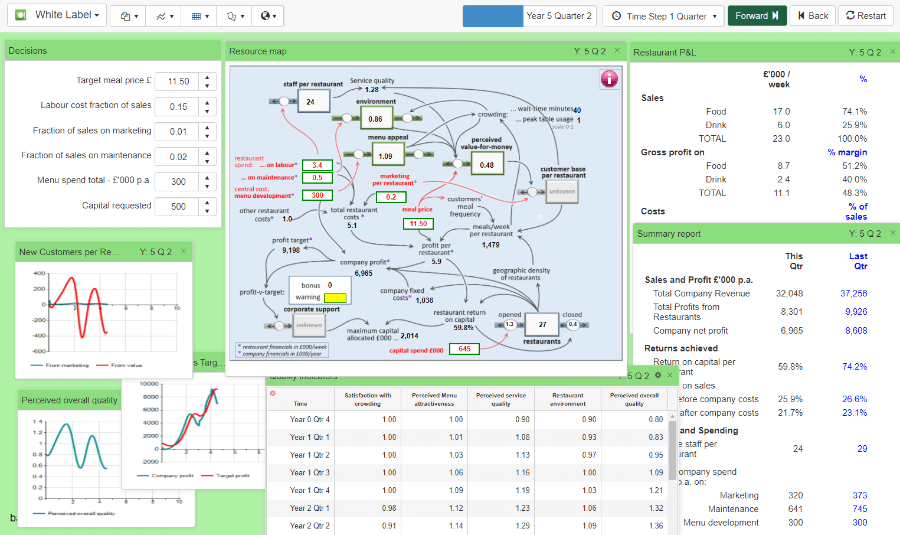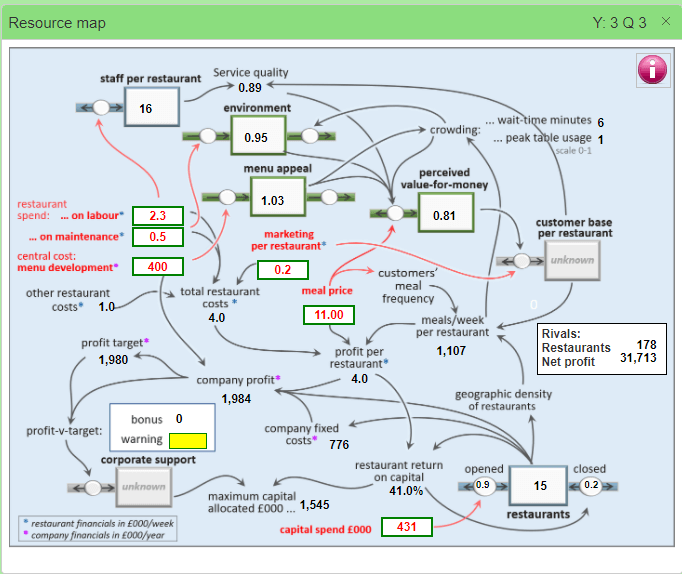White Label Restaurants
Balancing demands of Head Office and consumers
The White Label Restaurants game offers the challenge of growing a multiple consumer retailing business over as much as 10 years. At first, there is considerable undeveloped opportunity, but as restaurant numbers increase, it becomes increasingly difficult to drive further growth.
Players act as the management team, taking on the business with some history of growth and performance in earlier years. Decisions control customer experience, profitability, and business growth. 'Head Quarters' rewards success – or punishes failure! – and allocate capital to expand the business.
The challenges provided with the simulation allow players to tackle these issues from several different starting situations – a business that is already growing fast, another that must be rescued from disaster, or the challenge of chasing a rival who are already exploiting the market. Players can pursue a variety of goals: building the firm's sales or profitability; growing and maintaining 'shareholder value', or simply seeking personal rewards from profit-related bonuses.
Play Video
Video: Overview of the interface, no audio (4 mins)
Play Video
Video: Instructors introduction, with audio (8 mins)

Features
Initial conditions
The players's role is as the executive management of a business starting with 10 restaurants. Sales and profits are stated for both the average restaurant and for the whole business. The business is part of a larger group and receives profit targets, management bonuses and capital allocation from 'Head Office'.
The simulation runs for up to 10 years, with quarterly decisions, but intriguing situations can be run over just 3-4 years.
Objectives
Grow the business profitably in a large but finite market, making decisions that determine customers’ experience and growth by opening new restaurants. Balance the competing demands of Head Office and customers.
Setup
In the base case players elect whether to run with or without a competitor. The competitor can be set to start immediately, or some time after the player's business starts developing.(Note there is no competition between different players, to ensure that performance outcomes reflect their own expertise.)
Competitor strength can be varied, which determines the rate at which it grows.
| Feature List | |
|---|---|
| DECISIONS | Six decisions: Typical meal price, percentage of revenue spent on restaurant staffing, marketing and property maintenance, spend on menu development and capital requested from head office for opening new restaurants. Players choose when to run forward and the simulation runs forward one quarter with each step, or can choose to repeat decisions over several quarters. The game is automatically saved after each player action, minimising chances of data loss. A 'Go back' option allows previous decisions to be revised an alternative strategies explored. |
| HEAD OFFICE FEEDBACK | Performance bonuses, reflecting profits achieved vs. moving targets set by Head Office. Performance warnings for failure to hit profit targets, resulting in the player being fired if failure persists. |
| CHALLENGES | Seven challenges included - part played scenarios that provide different situations for students to work with. |
| SAVE CHALLENGES | Teams can save the game at any point, to explore alternative strategies. |
| RESOURCE MAP | A 'Resource Map' showing inter-relationships between 30+ key measures (if enabled). |
| REPORTS | Seven numerical reports showing relevant end of quarter financial and operational data plus an 'End of game' report giving a performance summary. |
| GRAPHS | Extensive pre-set charts showing the history of key data items. Additionally, Any item appearing in a table can be represented as a graph - simply double click on the table heading. |
| TABLE DATA | Tables show history of financial and service data, as well as a single table of all public data and one of user decsions. Tables can be exported in CSV format to enable analysis. |
| SAVE COMMENTS WITH GAMES | Can add comments to games either for display in games list or in a "Game Notepad". |
| COPY TO OTHER APPLICATIONS | Use screen capture to obtain images of Reports or Graphs for copying into other applications for inclusion in documents and slide presentations produced. |
| TEACHERS MATERIALS | Event managers materials include the user’s guide as well as instructor’s slides and slide notes. |
Uses
This game can be played by individuals or small teams. It plays out business performance over a time-scale that is long enough to experience the complexity of strategy and decision-making. Teams control strategy by making a small number of key decisions, and can progress through the simulation at their own pace, trying alternatives and saving scenarios.
Event materials include the user's guide for students and, for instructor's, slides and slide notes.
The courses in which it may be useful are:
Strategy Dynamics - the business resource-system, interdependence between firm resources, managing functions in harmony (sales and advertising).
Strategy courses or workshops - basics of resource-based view (RBV): connection between resources and performance.
Systems thinking courses or workshops - resource-building and feedback (reinforcing)
Marketing courses or workshops - basics of developing both customers (through advertising) and channels (through sales force), working with limited marketing budgets.
Key learning points
Business performance over time (sales and earnings) depends on the organisations resources.
Resources are won and lost over time (customers = sum of all customers won, minus all lost).
Resources bring with them a characteristic contribution to the rest of the system (increasing restaurant numbers brings a diminishing incremental market opportunity).
Growth depends on existing resources, including intangible factors (customers are won if service, menu, and environment are acceptable vs. the price charged).
and
Business growth depends on winning investor support (i.e. headquarters allocation of capital expenditure). Maximising value in a mature market - difficult because market exploitation inevitably imposes limits on further opportunities to grow.
Shareholder value reflects earnings growth, not merely earnings levels (and hence is hard to sustain).

Reviews
This Restaurant simulation was used for a number of years at this institution to great effect. More recently it has taken a fundamental role in the Food & beverage Management course at Undergraduate level.
As programme leader for the Bachelor degree programme at Glion Institute of Higher Education in Switzerland I am happy to recommend the use of the White Label Microworld software supplied by Strategy Dynamics.
This Restaurant simulation has been used for a number of years at this institution to great effect. For several years it provided a fundamental role in the Food & beverage Management course at Undergraduate level.
The software gives faculty a base on which to develop the use of strategy and its effects on business in a realistic virtual environment whilst providing the students a platform on which to develop their understanding of strategy through practice and the use of varying scenario's.
I am confident to say that we would not experience such a high level of competence among our students without he integration of this software to our curriculum.
The support offered by Strategy Dynamics is also of the highest order.
Paul Chappell, Glion Institute of Higher Education
I used the Restaurants simulation from Strategy Dynamics very successfully with a variety of students groups (MBA and senior undergraduates) in the UK and overseas (Netherlands, Switzerland and Hong Kong), across a range of classes (strategic management and service operations management) in a wide range of roles (e.g. running alongside a lecture programme, intensively over a weekend etc). It is a powerful and highly flexible pedagogical tool for facilitating students' understanding of the realities and complexities of managing dynamic resources and the vital need to develop and implement sustainable long-term strategies.
J Stephen Taylor, Edinburgh Napier University
Many, many thanks for all the support you have given me in these last years of using the game. I really enjoyed the simulation and in fact each time I discovered new things to show students. What an amazing simulation.
I really truly enjoyed the games, the challenges and the various points of views you can take when looking at the data. This is great stuff.
Caroline Boscacci
Glion Institut des Hautes Etudes

Can you satisfy both investors' desire for profitable growth and customers' wish for quality meals and service - especially when a rival is after the same market?
In a market familiar to most people this game plays out business performance over a time-scale that is long enough to experience the complexity of strategy and decision-making.
Play a demo
Teachers can request access to full game and inspection documentation for evaluation